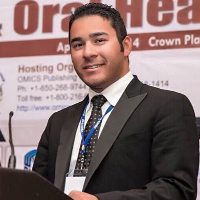Enamel Erosion by 15% and 18% Hydrochloric Acid Gels after Different Application Times
Author(s):
Abstract:
Background and Aim
Discolored teeth are among the most common reasons behind seeking esthetic dental treatments. Resin infiltration is a new technique for treatment of white spot lesions (WSLs). In this technique, 15% hydrochloric acid (HCl) is used to cause surface erosion. The aim of this study was to compare the enamel erosion caused by 15% and 18% HCl gels after different application times.
Materials and Methods
In this experimental study, sixty sound enamel surfaces were randomly divided into six groups of 10 (G1-G6). G1 specimens were subjected to 15% HCl gel for 75 seconds. G2 and G3 samples were subjected to 15% HCl for 90 and 120 seconds, respectively. G4, G5, and G6 specimens were subjected to 18% HCl for 75, 90, and 120 seconds, respectively. The specimens were then evaluated under a scanning electron microscope (SEM), and the depth of erosion was recorded. Data were analyzed by using one-way analysis of variance (ANOVA) and Tukey’s post-hoc test with a 95% confidence interval.
Results
The depth of erosion in 18% HCl groups was greater than that in 15% HCl groups after the same application times (P<0.05). The depth of erosion was not significantly different between G3 and G4 samples (P>0.05).
Conclusion
The results of this study showed that the application of 18% HCl for 75 seconds is a suitable alternative to the application of 15% HCl for 120 seconds in the resin infiltration technique.Language:
English
Published:
Journal of Research in Dental and Maxillofacial Sciences, Volume:2 Issue: 4, Autumn 2017
Pages:
14 to 19
magiran.com/p1942082
دانلود و مطالعه متن این مقاله با یکی از روشهای زیر امکان پذیر است:
اشتراک شخصی
با عضویت و پرداخت آنلاین حق اشتراک یکساله به مبلغ 1,390,000ريال میتوانید 70 عنوان مطلب دانلود کنید!
اشتراک سازمانی
به کتابخانه دانشگاه یا محل کار خود پیشنهاد کنید تا اشتراک سازمانی این پایگاه را برای دسترسی نامحدود همه کاربران به متن مطالب تهیه نمایند!
توجه!
- حق عضویت دریافتی صرف حمایت از نشریات عضو و نگهداری، تکمیل و توسعه مگیران میشود.
- پرداخت حق اشتراک و دانلود مقالات اجازه بازنشر آن در سایر رسانههای چاپی و دیجیتال را به کاربر نمیدهد.
In order to view content subscription is required
Personal subscription
Subscribe magiran.com for 70 € euros via PayPal and download 70 articles during a year.
Organization subscription
Please contact us to subscribe your university or library for unlimited access!



